IP Protection and Regulation: Strategies for Business Growth
VerifiedAdded on 2023/01/18
|19
|5739
|1
Report
AI Summary
This report provides a comprehensive overview of intellectual property (IP) protection and regulation, with a specific focus on the Chinese market. It begins by defining intellectual property rights, including trademarks, patents, and copyrights, and explores the legal frameworks governing IP in China. The report delves into the risks associated with IP, such as infringement and counterfeiting, and outlines effective risk management strategies. It examines the enforcement of IP rights, including legal actions and government initiatives, and discusses current policies and strategies in China. The report also highlights the advantages of IP protection and regulation for businesses, emphasizing the importance of registering IP rights and implementing proactive measures to safeguard intellectual assets. The analysis includes the importance of IP protection in the Chinese market and the need for businesses to navigate its complex legal landscape. Finally, the report emphasizes the importance of protecting intellectual property rights for business growth and success.
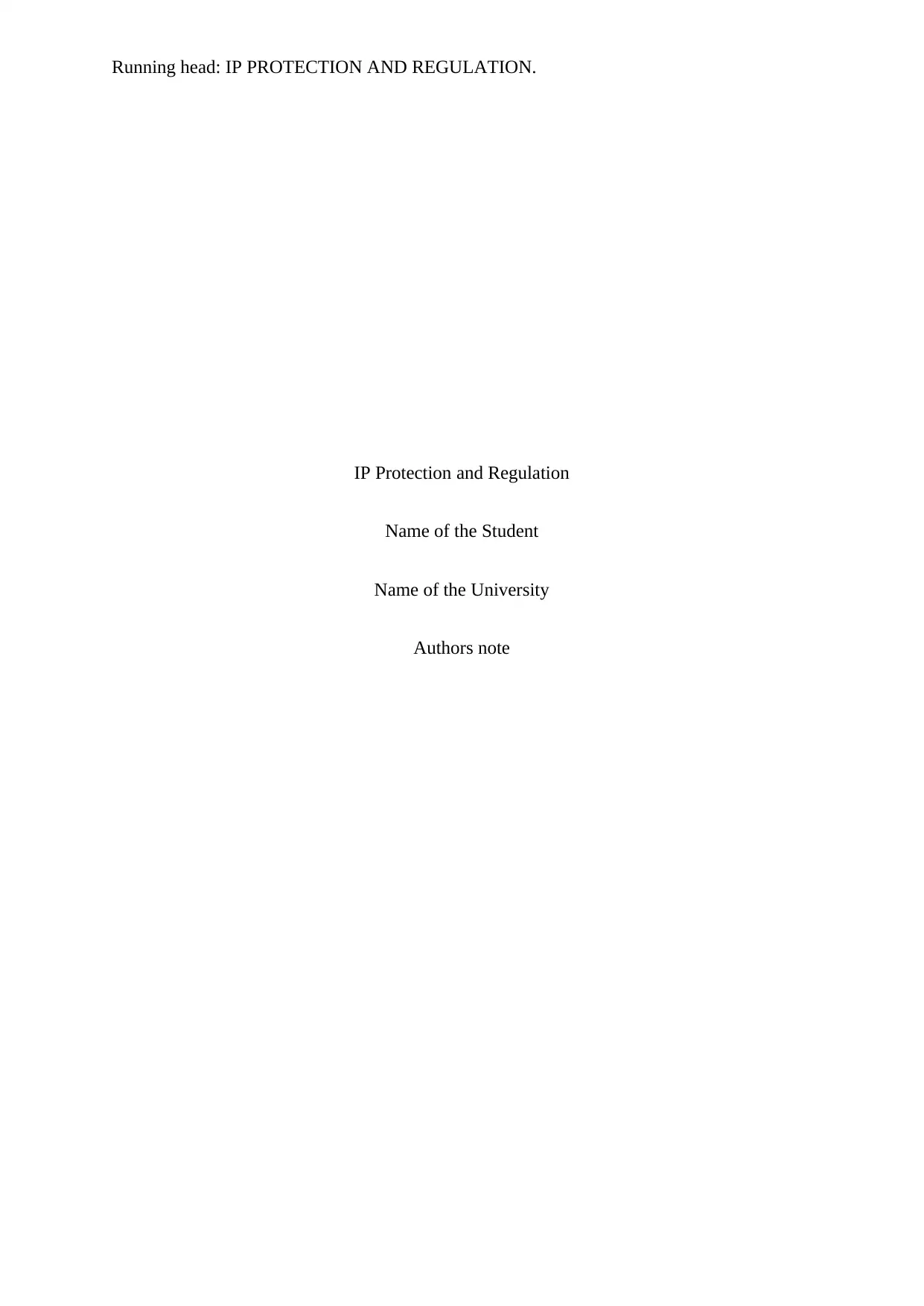
Running head: IP PROTECTION AND REGULATION.
IP Protection and Regulation
Name of the Student
Name of the University
Authors note
IP Protection and Regulation
Name of the Student
Name of the University
Authors note
Paraphrase This Document
Need a fresh take? Get an instant paraphrase of this document with our AI Paraphraser
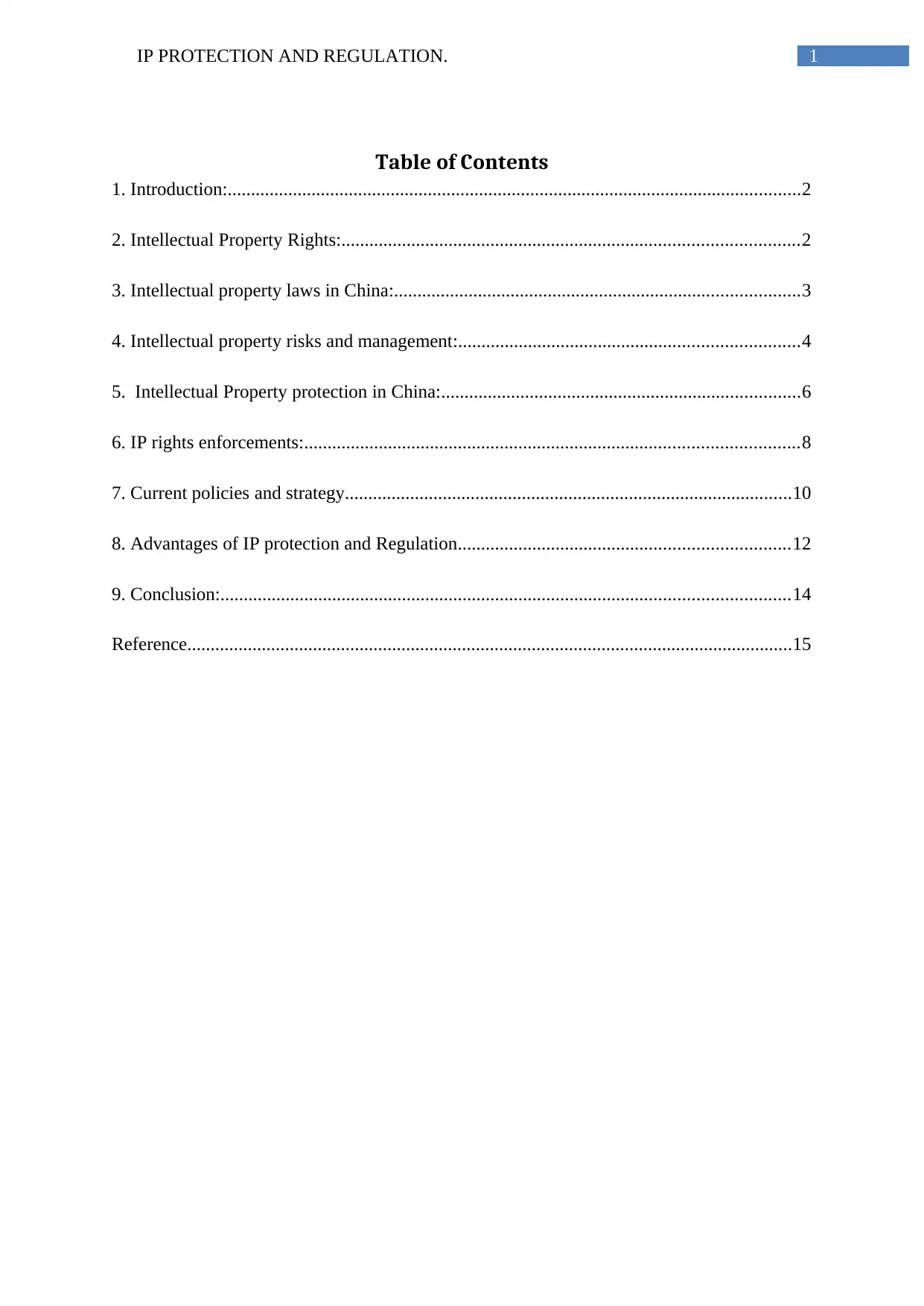
1IP PROTECTION AND REGULATION.
Table of Contents
1. Introduction:...........................................................................................................................2
2. Intellectual Property Rights:..................................................................................................2
3. Intellectual property laws in China:.......................................................................................3
4. Intellectual property risks and management:.........................................................................4
5. Intellectual Property protection in China:.............................................................................6
6. IP rights enforcements:..........................................................................................................8
7. Current policies and strategy................................................................................................10
8. Advantages of IP protection and Regulation.......................................................................12
9. Conclusion:..........................................................................................................................14
Reference..................................................................................................................................15
Table of Contents
1. Introduction:...........................................................................................................................2
2. Intellectual Property Rights:..................................................................................................2
3. Intellectual property laws in China:.......................................................................................3
4. Intellectual property risks and management:.........................................................................4
5. Intellectual Property protection in China:.............................................................................6
6. IP rights enforcements:..........................................................................................................8
7. Current policies and strategy................................................................................................10
8. Advantages of IP protection and Regulation.......................................................................12
9. Conclusion:..........................................................................................................................14
Reference..................................................................................................................................15
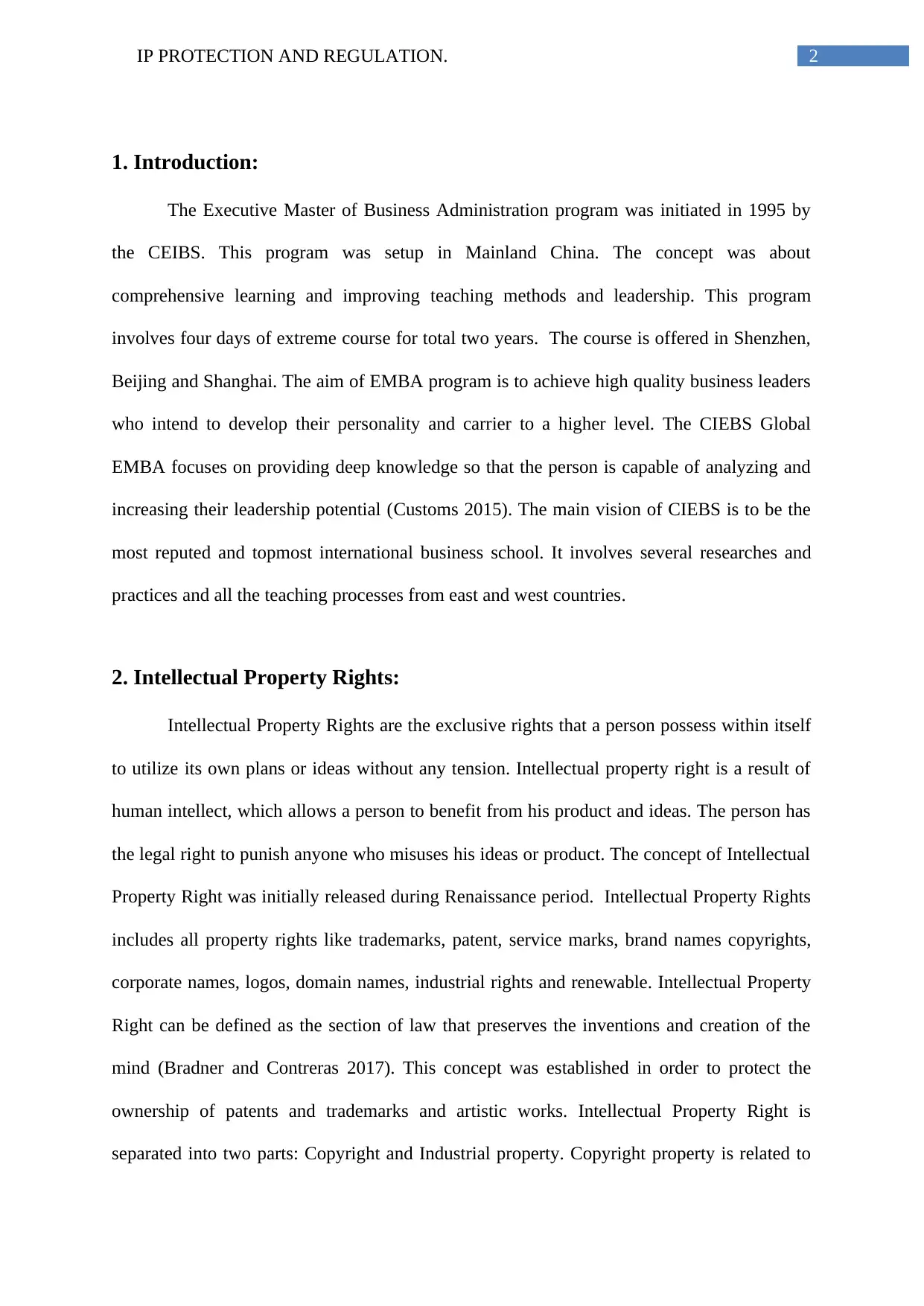
2IP PROTECTION AND REGULATION.
1. Introduction:
The Executive Master of Business Administration program was initiated in 1995 by
the CEIBS. This program was setup in Mainland China. The concept was about
comprehensive learning and improving teaching methods and leadership. This program
involves four days of extreme course for total two years. The course is offered in Shenzhen,
Beijing and Shanghai. The aim of EMBA program is to achieve high quality business leaders
who intend to develop their personality and carrier to a higher level. The CIEBS Global
EMBA focuses on providing deep knowledge so that the person is capable of analyzing and
increasing their leadership potential (Customs 2015). The main vision of CIEBS is to be the
most reputed and topmost international business school. It involves several researches and
practices and all the teaching processes from east and west countries.
2. Intellectual Property Rights:
Intellectual Property Rights are the exclusive rights that a person possess within itself
to utilize its own plans or ideas without any tension. Intellectual property right is a result of
human intellect, which allows a person to benefit from his product and ideas. The person has
the legal right to punish anyone who misuses his ideas or product. The concept of Intellectual
Property Right was initially released during Renaissance period. Intellectual Property Rights
includes all property rights like trademarks, patent, service marks, brand names copyrights,
corporate names, logos, domain names, industrial rights and renewable. Intellectual Property
Right can be defined as the section of law that preserves the inventions and creation of the
mind (Bradner and Contreras 2017). This concept was established in order to protect the
ownership of patents and trademarks and artistic works. Intellectual Property Right is
separated into two parts: Copyright and Industrial property. Copyright property is related to
1. Introduction:
The Executive Master of Business Administration program was initiated in 1995 by
the CEIBS. This program was setup in Mainland China. The concept was about
comprehensive learning and improving teaching methods and leadership. This program
involves four days of extreme course for total two years. The course is offered in Shenzhen,
Beijing and Shanghai. The aim of EMBA program is to achieve high quality business leaders
who intend to develop their personality and carrier to a higher level. The CIEBS Global
EMBA focuses on providing deep knowledge so that the person is capable of analyzing and
increasing their leadership potential (Customs 2015). The main vision of CIEBS is to be the
most reputed and topmost international business school. It involves several researches and
practices and all the teaching processes from east and west countries.
2. Intellectual Property Rights:
Intellectual Property Rights are the exclusive rights that a person possess within itself
to utilize its own plans or ideas without any tension. Intellectual property right is a result of
human intellect, which allows a person to benefit from his product and ideas. The person has
the legal right to punish anyone who misuses his ideas or product. The concept of Intellectual
Property Right was initially released during Renaissance period. Intellectual Property Rights
includes all property rights like trademarks, patent, service marks, brand names copyrights,
corporate names, logos, domain names, industrial rights and renewable. Intellectual Property
Right can be defined as the section of law that preserves the inventions and creation of the
mind (Bradner and Contreras 2017). This concept was established in order to protect the
ownership of patents and trademarks and artistic works. Intellectual Property Right is
separated into two parts: Copyright and Industrial property. Copyright property is related to
⊘ This is a preview!⊘
Do you want full access?
Subscribe today to unlock all pages.

Trusted by 1+ million students worldwide
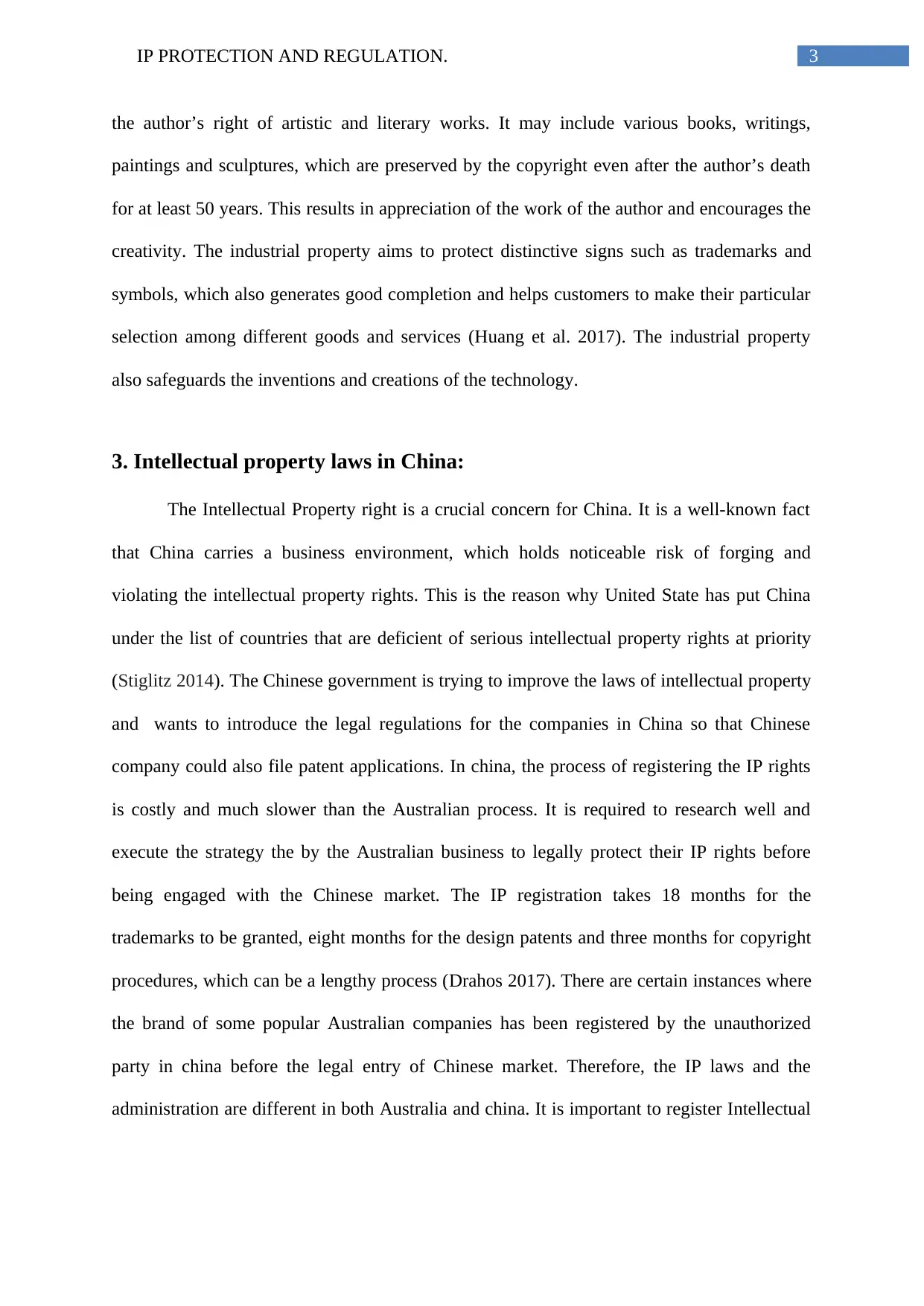
3IP PROTECTION AND REGULATION.
the author’s right of artistic and literary works. It may include various books, writings,
paintings and sculptures, which are preserved by the copyright even after the author’s death
for at least 50 years. This results in appreciation of the work of the author and encourages the
creativity. The industrial property aims to protect distinctive signs such as trademarks and
symbols, which also generates good completion and helps customers to make their particular
selection among different goods and services (Huang et al. 2017). The industrial property
also safeguards the inventions and creations of the technology.
3. Intellectual property laws in China:
The Intellectual Property right is a crucial concern for China. It is a well-known fact
that China carries a business environment, which holds noticeable risk of forging and
violating the intellectual property rights. This is the reason why United State has put China
under the list of countries that are deficient of serious intellectual property rights at priority
(Stiglitz 2014). The Chinese government is trying to improve the laws of intellectual property
and wants to introduce the legal regulations for the companies in China so that Chinese
company could also file patent applications. In china, the process of registering the IP rights
is costly and much slower than the Australian process. It is required to research well and
execute the strategy the by the Australian business to legally protect their IP rights before
being engaged with the Chinese market. The IP registration takes 18 months for the
trademarks to be granted, eight months for the design patents and three months for copyright
procedures, which can be a lengthy process (Drahos 2017). There are certain instances where
the brand of some popular Australian companies has been registered by the unauthorized
party in china before the legal entry of Chinese market. Therefore, the IP laws and the
administration are different in both Australia and china. It is important to register Intellectual
the author’s right of artistic and literary works. It may include various books, writings,
paintings and sculptures, which are preserved by the copyright even after the author’s death
for at least 50 years. This results in appreciation of the work of the author and encourages the
creativity. The industrial property aims to protect distinctive signs such as trademarks and
symbols, which also generates good completion and helps customers to make their particular
selection among different goods and services (Huang et al. 2017). The industrial property
also safeguards the inventions and creations of the technology.
3. Intellectual property laws in China:
The Intellectual Property right is a crucial concern for China. It is a well-known fact
that China carries a business environment, which holds noticeable risk of forging and
violating the intellectual property rights. This is the reason why United State has put China
under the list of countries that are deficient of serious intellectual property rights at priority
(Stiglitz 2014). The Chinese government is trying to improve the laws of intellectual property
and wants to introduce the legal regulations for the companies in China so that Chinese
company could also file patent applications. In china, the process of registering the IP rights
is costly and much slower than the Australian process. It is required to research well and
execute the strategy the by the Australian business to legally protect their IP rights before
being engaged with the Chinese market. The IP registration takes 18 months for the
trademarks to be granted, eight months for the design patents and three months for copyright
procedures, which can be a lengthy process (Drahos 2017). There are certain instances where
the brand of some popular Australian companies has been registered by the unauthorized
party in china before the legal entry of Chinese market. Therefore, the IP laws and the
administration are different in both Australia and china. It is important to register Intellectual
Paraphrase This Document
Need a fresh take? Get an instant paraphrase of this document with our AI Paraphraser
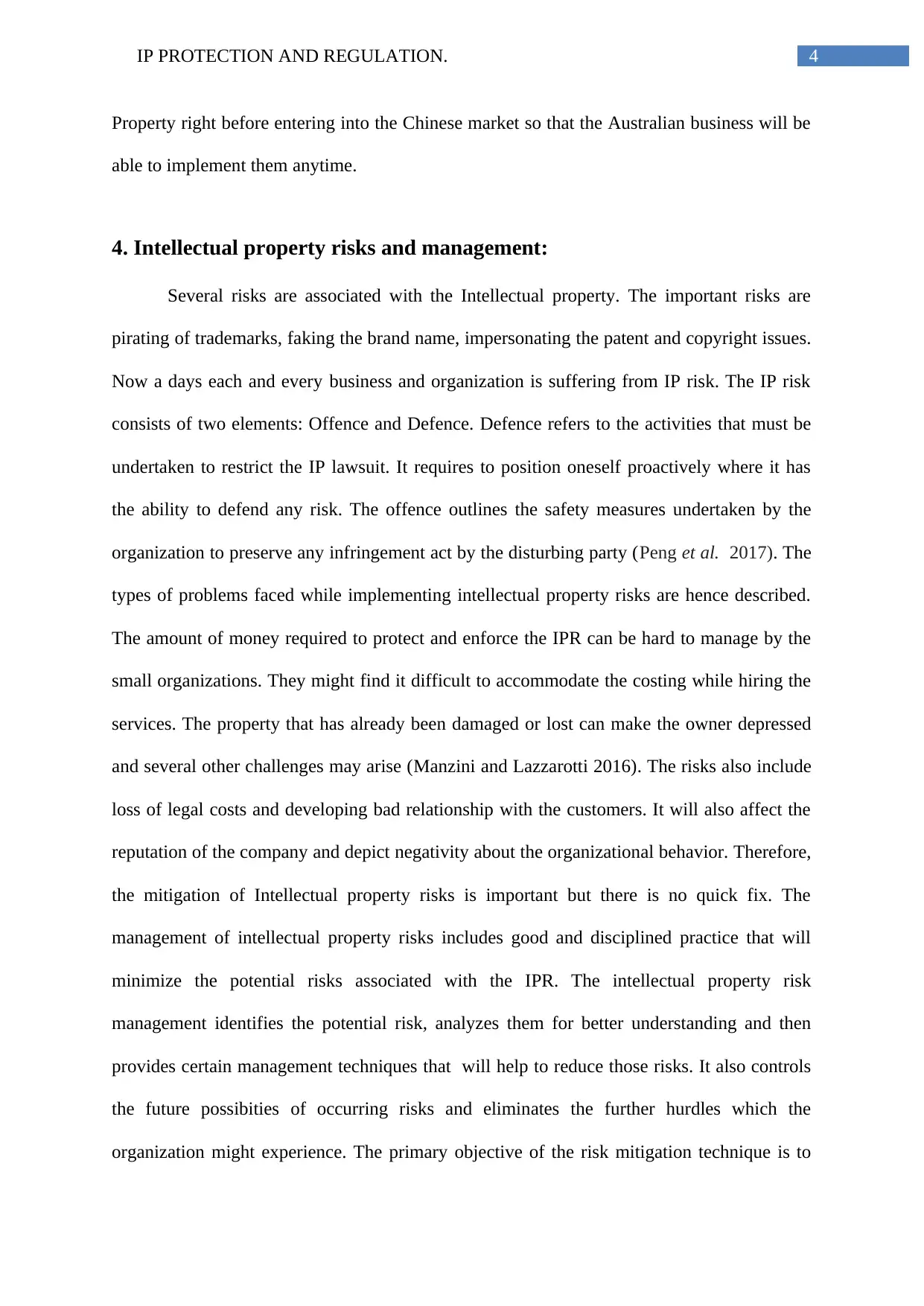
4IP PROTECTION AND REGULATION.
Property right before entering into the Chinese market so that the Australian business will be
able to implement them anytime.
4. Intellectual property risks and management:
Several risks are associated with the Intellectual property. The important risks are
pirating of trademarks, faking the brand name, impersonating the patent and copyright issues.
Now a days each and every business and organization is suffering from IP risk. The IP risk
consists of two elements: Offence and Defence. Defence refers to the activities that must be
undertaken to restrict the IP lawsuit. It requires to position oneself proactively where it has
the ability to defend any risk. The offence outlines the safety measures undertaken by the
organization to preserve any infringement act by the disturbing party (Peng et al. 2017). The
types of problems faced while implementing intellectual property risks are hence described.
The amount of money required to protect and enforce the IPR can be hard to manage by the
small organizations. They might find it difficult to accommodate the costing while hiring the
services. The property that has already been damaged or lost can make the owner depressed
and several other challenges may arise (Manzini and Lazzarotti 2016). The risks also include
loss of legal costs and developing bad relationship with the customers. It will also affect the
reputation of the company and depict negativity about the organizational behavior. Therefore,
the mitigation of Intellectual property risks is important but there is no quick fix. The
management of intellectual property risks includes good and disciplined practice that will
minimize the potential risks associated with the IPR. The intellectual property risk
management identifies the potential risk, analyzes them for better understanding and then
provides certain management techniques that will help to reduce those risks. It also controls
the future possibities of occurring risks and eliminates the further hurdles which the
organization might experience. The primary objective of the risk mitigation technique is to
Property right before entering into the Chinese market so that the Australian business will be
able to implement them anytime.
4. Intellectual property risks and management:
Several risks are associated with the Intellectual property. The important risks are
pirating of trademarks, faking the brand name, impersonating the patent and copyright issues.
Now a days each and every business and organization is suffering from IP risk. The IP risk
consists of two elements: Offence and Defence. Defence refers to the activities that must be
undertaken to restrict the IP lawsuit. It requires to position oneself proactively where it has
the ability to defend any risk. The offence outlines the safety measures undertaken by the
organization to preserve any infringement act by the disturbing party (Peng et al. 2017). The
types of problems faced while implementing intellectual property risks are hence described.
The amount of money required to protect and enforce the IPR can be hard to manage by the
small organizations. They might find it difficult to accommodate the costing while hiring the
services. The property that has already been damaged or lost can make the owner depressed
and several other challenges may arise (Manzini and Lazzarotti 2016). The risks also include
loss of legal costs and developing bad relationship with the customers. It will also affect the
reputation of the company and depict negativity about the organizational behavior. Therefore,
the mitigation of Intellectual property risks is important but there is no quick fix. The
management of intellectual property risks includes good and disciplined practice that will
minimize the potential risks associated with the IPR. The intellectual property risk
management identifies the potential risk, analyzes them for better understanding and then
provides certain management techniques that will help to reduce those risks. It also controls
the future possibities of occurring risks and eliminates the further hurdles which the
organization might experience. The primary objective of the risk mitigation technique is to
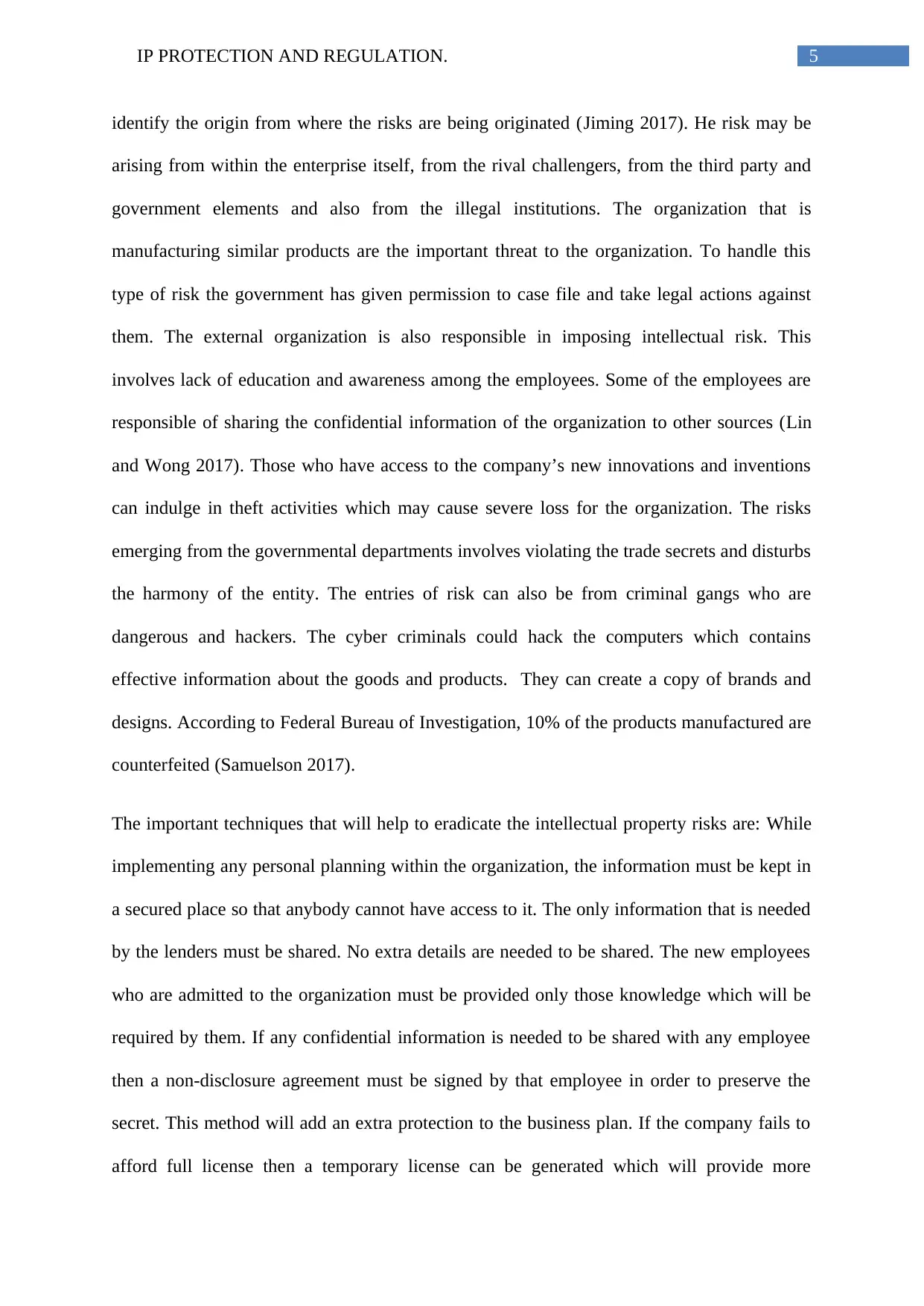
5IP PROTECTION AND REGULATION.
identify the origin from where the risks are being originated (Jiming 2017). He risk may be
arising from within the enterprise itself, from the rival challengers, from the third party and
government elements and also from the illegal institutions. The organization that is
manufacturing similar products are the important threat to the organization. To handle this
type of risk the government has given permission to case file and take legal actions against
them. The external organization is also responsible in imposing intellectual risk. This
involves lack of education and awareness among the employees. Some of the employees are
responsible of sharing the confidential information of the organization to other sources (Lin
and Wong 2017). Those who have access to the company’s new innovations and inventions
can indulge in theft activities which may cause severe loss for the organization. The risks
emerging from the governmental departments involves violating the trade secrets and disturbs
the harmony of the entity. The entries of risk can also be from criminal gangs who are
dangerous and hackers. The cyber criminals could hack the computers which contains
effective information about the goods and products. They can create a copy of brands and
designs. According to Federal Bureau of Investigation, 10% of the products manufactured are
counterfeited (Samuelson 2017).
The important techniques that will help to eradicate the intellectual property risks are: While
implementing any personal planning within the organization, the information must be kept in
a secured place so that anybody cannot have access to it. The only information that is needed
by the lenders must be shared. No extra details are needed to be shared. The new employees
who are admitted to the organization must be provided only those knowledge which will be
required by them. If any confidential information is needed to be shared with any employee
then a non-disclosure agreement must be signed by that employee in order to preserve the
secret. This method will add an extra protection to the business plan. If the company fails to
afford full license then a temporary license can be generated which will provide more
identify the origin from where the risks are being originated (Jiming 2017). He risk may be
arising from within the enterprise itself, from the rival challengers, from the third party and
government elements and also from the illegal institutions. The organization that is
manufacturing similar products are the important threat to the organization. To handle this
type of risk the government has given permission to case file and take legal actions against
them. The external organization is also responsible in imposing intellectual risk. This
involves lack of education and awareness among the employees. Some of the employees are
responsible of sharing the confidential information of the organization to other sources (Lin
and Wong 2017). Those who have access to the company’s new innovations and inventions
can indulge in theft activities which may cause severe loss for the organization. The risks
emerging from the governmental departments involves violating the trade secrets and disturbs
the harmony of the entity. The entries of risk can also be from criminal gangs who are
dangerous and hackers. The cyber criminals could hack the computers which contains
effective information about the goods and products. They can create a copy of brands and
designs. According to Federal Bureau of Investigation, 10% of the products manufactured are
counterfeited (Samuelson 2017).
The important techniques that will help to eradicate the intellectual property risks are: While
implementing any personal planning within the organization, the information must be kept in
a secured place so that anybody cannot have access to it. The only information that is needed
by the lenders must be shared. No extra details are needed to be shared. The new employees
who are admitted to the organization must be provided only those knowledge which will be
required by them. If any confidential information is needed to be shared with any employee
then a non-disclosure agreement must be signed by that employee in order to preserve the
secret. This method will add an extra protection to the business plan. If the company fails to
afford full license then a temporary license can be generated which will provide more
⊘ This is a preview!⊘
Do you want full access?
Subscribe today to unlock all pages.

Trusted by 1+ million students worldwide
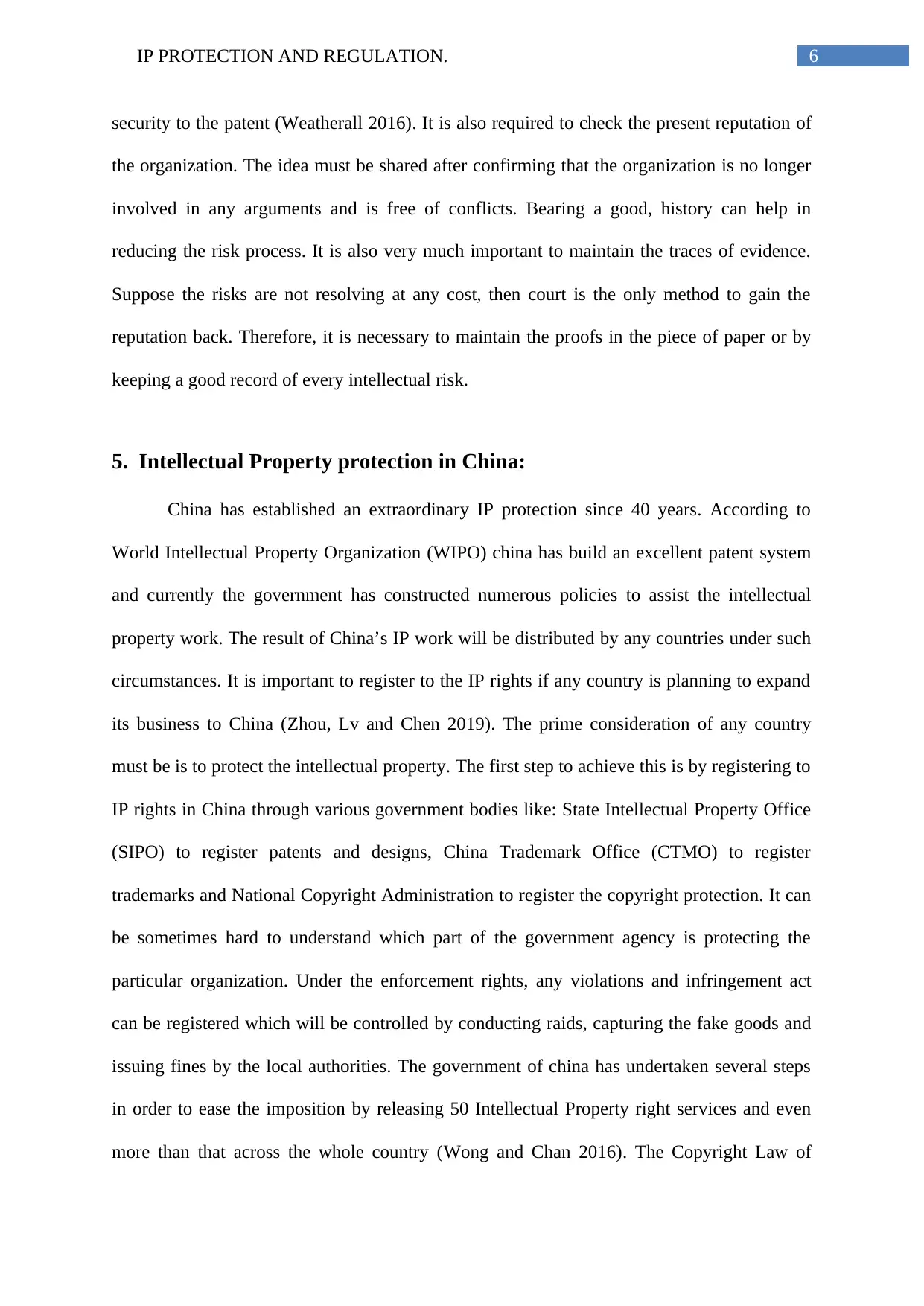
6IP PROTECTION AND REGULATION.
security to the patent (Weatherall 2016). It is also required to check the present reputation of
the organization. The idea must be shared after confirming that the organization is no longer
involved in any arguments and is free of conflicts. Bearing a good, history can help in
reducing the risk process. It is also very much important to maintain the traces of evidence.
Suppose the risks are not resolving at any cost, then court is the only method to gain the
reputation back. Therefore, it is necessary to maintain the proofs in the piece of paper or by
keeping a good record of every intellectual risk.
5. Intellectual Property protection in China:
China has established an extraordinary IP protection since 40 years. According to
World Intellectual Property Organization (WIPO) china has build an excellent patent system
and currently the government has constructed numerous policies to assist the intellectual
property work. The result of China’s IP work will be distributed by any countries under such
circumstances. It is important to register to the IP rights if any country is planning to expand
its business to China (Zhou, Lv and Chen 2019). The prime consideration of any country
must be is to protect the intellectual property. The first step to achieve this is by registering to
IP rights in China through various government bodies like: State Intellectual Property Office
(SIPO) to register patents and designs, China Trademark Office (CTMO) to register
trademarks and National Copyright Administration to register the copyright protection. It can
be sometimes hard to understand which part of the government agency is protecting the
particular organization. Under the enforcement rights, any violations and infringement act
can be registered which will be controlled by conducting raids, capturing the fake goods and
issuing fines by the local authorities. The government of china has undertaken several steps
in order to ease the imposition by releasing 50 Intellectual Property right services and even
more than that across the whole country (Wong and Chan 2016). The Copyright Law of
security to the patent (Weatherall 2016). It is also required to check the present reputation of
the organization. The idea must be shared after confirming that the organization is no longer
involved in any arguments and is free of conflicts. Bearing a good, history can help in
reducing the risk process. It is also very much important to maintain the traces of evidence.
Suppose the risks are not resolving at any cost, then court is the only method to gain the
reputation back. Therefore, it is necessary to maintain the proofs in the piece of paper or by
keeping a good record of every intellectual risk.
5. Intellectual Property protection in China:
China has established an extraordinary IP protection since 40 years. According to
World Intellectual Property Organization (WIPO) china has build an excellent patent system
and currently the government has constructed numerous policies to assist the intellectual
property work. The result of China’s IP work will be distributed by any countries under such
circumstances. It is important to register to the IP rights if any country is planning to expand
its business to China (Zhou, Lv and Chen 2019). The prime consideration of any country
must be is to protect the intellectual property. The first step to achieve this is by registering to
IP rights in China through various government bodies like: State Intellectual Property Office
(SIPO) to register patents and designs, China Trademark Office (CTMO) to register
trademarks and National Copyright Administration to register the copyright protection. It can
be sometimes hard to understand which part of the government agency is protecting the
particular organization. Under the enforcement rights, any violations and infringement act
can be registered which will be controlled by conducting raids, capturing the fake goods and
issuing fines by the local authorities. The government of china has undertaken several steps
in order to ease the imposition by releasing 50 Intellectual Property right services and even
more than that across the whole country (Wong and Chan 2016). The Copyright Law of
Paraphrase This Document
Need a fresh take? Get an instant paraphrase of this document with our AI Paraphraser
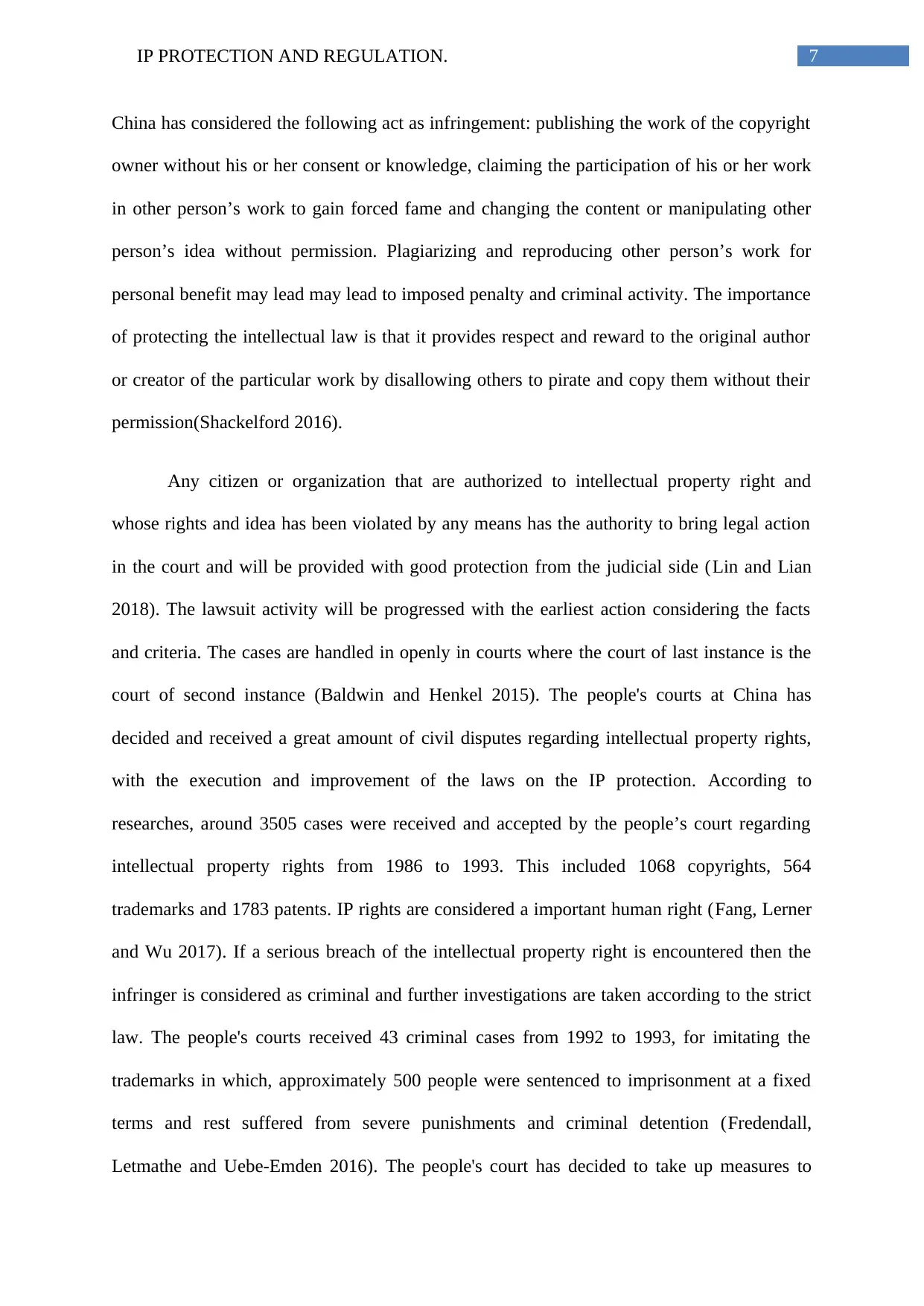
7IP PROTECTION AND REGULATION.
China has considered the following act as infringement: publishing the work of the copyright
owner without his or her consent or knowledge, claiming the participation of his or her work
in other person’s work to gain forced fame and changing the content or manipulating other
person’s idea without permission. Plagiarizing and reproducing other person’s work for
personal benefit may lead may lead to imposed penalty and criminal activity. The importance
of protecting the intellectual law is that it provides respect and reward to the original author
or creator of the particular work by disallowing others to pirate and copy them without their
permission(Shackelford 2016).
Any citizen or organization that are authorized to intellectual property right and
whose rights and idea has been violated by any means has the authority to bring legal action
in the court and will be provided with good protection from the judicial side (Lin and Lian
2018). The lawsuit activity will be progressed with the earliest action considering the facts
and criteria. The cases are handled in openly in courts where the court of last instance is the
court of second instance (Baldwin and Henkel 2015). The people's courts at China has
decided and received a great amount of civil disputes regarding intellectual property rights,
with the execution and improvement of the laws on the IP protection. According to
researches, around 3505 cases were received and accepted by the people’s court regarding
intellectual property rights from 1986 to 1993. This included 1068 copyrights, 564
trademarks and 1783 patents. IP rights are considered a important human right (Fang, Lerner
and Wu 2017). If a serious breach of the intellectual property right is encountered then the
infringer is considered as criminal and further investigations are taken according to the strict
law. The people's courts received 43 criminal cases from 1992 to 1993, for imitating the
trademarks in which, approximately 500 people were sentenced to imprisonment at a fixed
terms and rest suffered from severe punishments and criminal detention (Fredendall,
Letmathe and Uebe-Emden 2016). The people's court has decided to take up measures to
China has considered the following act as infringement: publishing the work of the copyright
owner without his or her consent or knowledge, claiming the participation of his or her work
in other person’s work to gain forced fame and changing the content or manipulating other
person’s idea without permission. Plagiarizing and reproducing other person’s work for
personal benefit may lead may lead to imposed penalty and criminal activity. The importance
of protecting the intellectual law is that it provides respect and reward to the original author
or creator of the particular work by disallowing others to pirate and copy them without their
permission(Shackelford 2016).
Any citizen or organization that are authorized to intellectual property right and
whose rights and idea has been violated by any means has the authority to bring legal action
in the court and will be provided with good protection from the judicial side (Lin and Lian
2018). The lawsuit activity will be progressed with the earliest action considering the facts
and criteria. The cases are handled in openly in courts where the court of last instance is the
court of second instance (Baldwin and Henkel 2015). The people's courts at China has
decided and received a great amount of civil disputes regarding intellectual property rights,
with the execution and improvement of the laws on the IP protection. According to
researches, around 3505 cases were received and accepted by the people’s court regarding
intellectual property rights from 1986 to 1993. This included 1068 copyrights, 564
trademarks and 1783 patents. IP rights are considered a important human right (Fang, Lerner
and Wu 2017). If a serious breach of the intellectual property right is encountered then the
infringer is considered as criminal and further investigations are taken according to the strict
law. The people's courts received 43 criminal cases from 1992 to 1993, for imitating the
trademarks in which, approximately 500 people were sentenced to imprisonment at a fixed
terms and rest suffered from severe punishments and criminal detention (Fredendall,
Letmathe and Uebe-Emden 2016). The people's court has decided to take up measures to
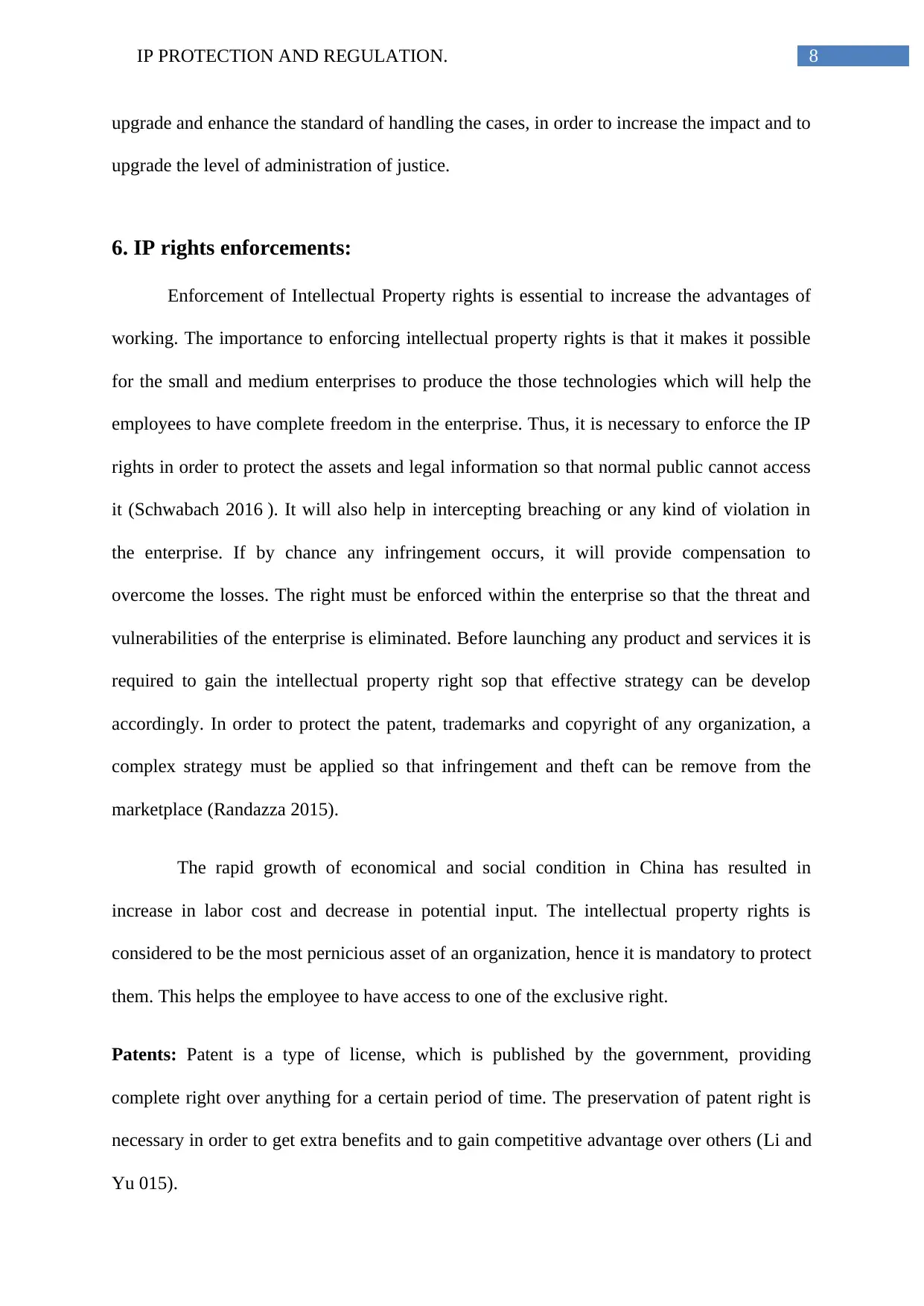
8IP PROTECTION AND REGULATION.
upgrade and enhance the standard of handling the cases, in order to increase the impact and to
upgrade the level of administration of justice.
6. IP rights enforcements:
Enforcement of Intellectual Property rights is essential to increase the advantages of
working. The importance to enforcing intellectual property rights is that it makes it possible
for the small and medium enterprises to produce the those technologies which will help the
employees to have complete freedom in the enterprise. Thus, it is necessary to enforce the IP
rights in order to protect the assets and legal information so that normal public cannot access
it (Schwabach 2016 ). It will also help in intercepting breaching or any kind of violation in
the enterprise. If by chance any infringement occurs, it will provide compensation to
overcome the losses. The right must be enforced within the enterprise so that the threat and
vulnerabilities of the enterprise is eliminated. Before launching any product and services it is
required to gain the intellectual property right sop that effective strategy can be develop
accordingly. In order to protect the patent, trademarks and copyright of any organization, a
complex strategy must be applied so that infringement and theft can be remove from the
marketplace (Randazza 2015).
The rapid growth of economical and social condition in China has resulted in
increase in labor cost and decrease in potential input. The intellectual property rights is
considered to be the most pernicious asset of an organization, hence it is mandatory to protect
them. This helps the employee to have access to one of the exclusive right.
Patents: Patent is a type of license, which is published by the government, providing
complete right over anything for a certain period of time. The preservation of patent right is
necessary in order to get extra benefits and to gain competitive advantage over others (Li and
Yu 015).
upgrade and enhance the standard of handling the cases, in order to increase the impact and to
upgrade the level of administration of justice.
6. IP rights enforcements:
Enforcement of Intellectual Property rights is essential to increase the advantages of
working. The importance to enforcing intellectual property rights is that it makes it possible
for the small and medium enterprises to produce the those technologies which will help the
employees to have complete freedom in the enterprise. Thus, it is necessary to enforce the IP
rights in order to protect the assets and legal information so that normal public cannot access
it (Schwabach 2016 ). It will also help in intercepting breaching or any kind of violation in
the enterprise. If by chance any infringement occurs, it will provide compensation to
overcome the losses. The right must be enforced within the enterprise so that the threat and
vulnerabilities of the enterprise is eliminated. Before launching any product and services it is
required to gain the intellectual property right sop that effective strategy can be develop
accordingly. In order to protect the patent, trademarks and copyright of any organization, a
complex strategy must be applied so that infringement and theft can be remove from the
marketplace (Randazza 2015).
The rapid growth of economical and social condition in China has resulted in
increase in labor cost and decrease in potential input. The intellectual property rights is
considered to be the most pernicious asset of an organization, hence it is mandatory to protect
them. This helps the employee to have access to one of the exclusive right.
Patents: Patent is a type of license, which is published by the government, providing
complete right over anything for a certain period of time. The preservation of patent right is
necessary in order to get extra benefits and to gain competitive advantage over others (Li and
Yu 015).
⊘ This is a preview!⊘
Do you want full access?
Subscribe today to unlock all pages.

Trusted by 1+ million students worldwide
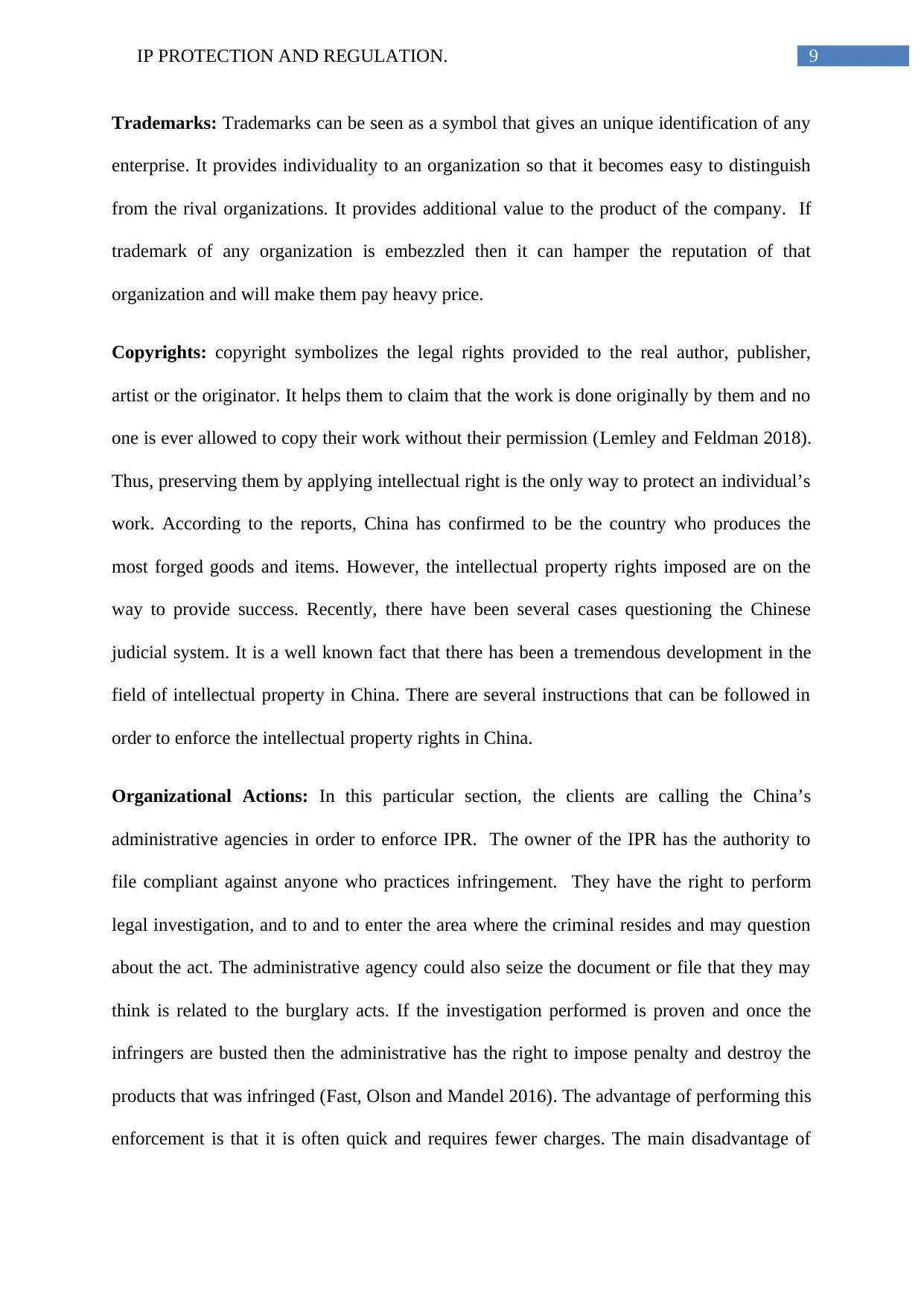
9IP PROTECTION AND REGULATION.
Trademarks: Trademarks can be seen as a symbol that gives an unique identification of any
enterprise. It provides individuality to an organization so that it becomes easy to distinguish
from the rival organizations. It provides additional value to the product of the company. If
trademark of any organization is embezzled then it can hamper the reputation of that
organization and will make them pay heavy price.
Copyrights: copyright symbolizes the legal rights provided to the real author, publisher,
artist or the originator. It helps them to claim that the work is done originally by them and no
one is ever allowed to copy their work without their permission (Lemley and Feldman 2018).
Thus, preserving them by applying intellectual right is the only way to protect an individual’s
work. According to the reports, China has confirmed to be the country who produces the
most forged goods and items. However, the intellectual property rights imposed are on the
way to provide success. Recently, there have been several cases questioning the Chinese
judicial system. It is a well known fact that there has been a tremendous development in the
field of intellectual property in China. There are several instructions that can be followed in
order to enforce the intellectual property rights in China.
Organizational Actions: In this particular section, the clients are calling the China’s
administrative agencies in order to enforce IPR. The owner of the IPR has the authority to
file compliant against anyone who practices infringement. They have the right to perform
legal investigation, and to and to enter the area where the criminal resides and may question
about the act. The administrative agency could also seize the document or file that they may
think is related to the burglary acts. If the investigation performed is proven and once the
infringers are busted then the administrative has the right to impose penalty and destroy the
products that was infringed (Fast, Olson and Mandel 2016). The advantage of performing this
enforcement is that it is often quick and requires fewer charges. The main disadvantage of
Trademarks: Trademarks can be seen as a symbol that gives an unique identification of any
enterprise. It provides individuality to an organization so that it becomes easy to distinguish
from the rival organizations. It provides additional value to the product of the company. If
trademark of any organization is embezzled then it can hamper the reputation of that
organization and will make them pay heavy price.
Copyrights: copyright symbolizes the legal rights provided to the real author, publisher,
artist or the originator. It helps them to claim that the work is done originally by them and no
one is ever allowed to copy their work without their permission (Lemley and Feldman 2018).
Thus, preserving them by applying intellectual right is the only way to protect an individual’s
work. According to the reports, China has confirmed to be the country who produces the
most forged goods and items. However, the intellectual property rights imposed are on the
way to provide success. Recently, there have been several cases questioning the Chinese
judicial system. It is a well known fact that there has been a tremendous development in the
field of intellectual property in China. There are several instructions that can be followed in
order to enforce the intellectual property rights in China.
Organizational Actions: In this particular section, the clients are calling the China’s
administrative agencies in order to enforce IPR. The owner of the IPR has the authority to
file compliant against anyone who practices infringement. They have the right to perform
legal investigation, and to and to enter the area where the criminal resides and may question
about the act. The administrative agency could also seize the document or file that they may
think is related to the burglary acts. If the investigation performed is proven and once the
infringers are busted then the administrative has the right to impose penalty and destroy the
products that was infringed (Fast, Olson and Mandel 2016). The advantage of performing this
enforcement is that it is often quick and requires fewer charges. The main disadvantage of
Paraphrase This Document
Need a fresh take? Get an instant paraphrase of this document with our AI Paraphraser
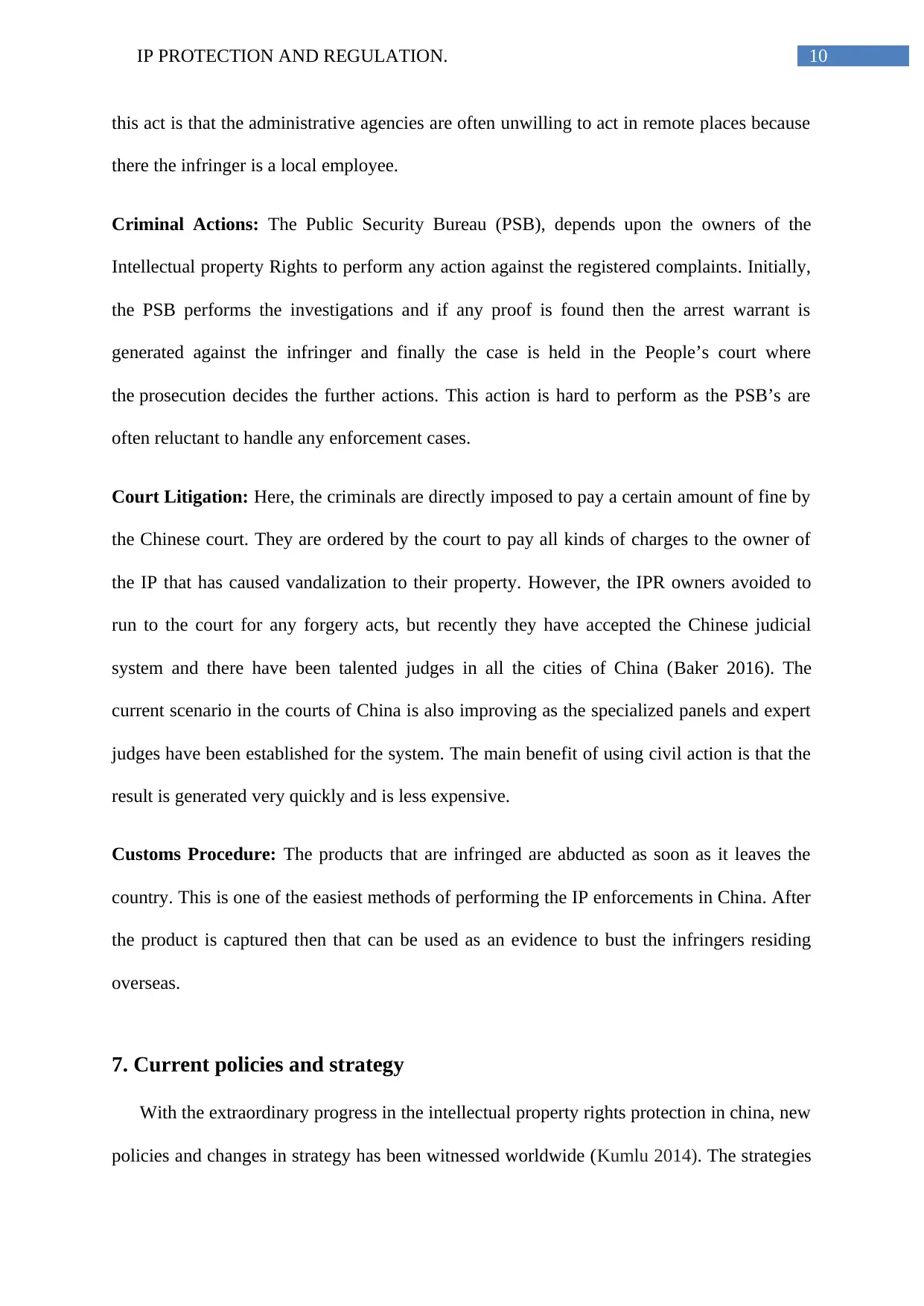
10IP PROTECTION AND REGULATION.
this act is that the administrative agencies are often unwilling to act in remote places because
there the infringer is a local employee.
Criminal Actions: The Public Security Bureau (PSB), depends upon the owners of the
Intellectual property Rights to perform any action against the registered complaints. Initially,
the PSB performs the investigations and if any proof is found then the arrest warrant is
generated against the infringer and finally the case is held in the People’s court where
the prosecution decides the further actions. This action is hard to perform as the PSB’s are
often reluctant to handle any enforcement cases.
Court Litigation: Here, the criminals are directly imposed to pay a certain amount of fine by
the Chinese court. They are ordered by the court to pay all kinds of charges to the owner of
the IP that has caused vandalization to their property. However, the IPR owners avoided to
run to the court for any forgery acts, but recently they have accepted the Chinese judicial
system and there have been talented judges in all the cities of China (Baker 2016). The
current scenario in the courts of China is also improving as the specialized panels and expert
judges have been established for the system. The main benefit of using civil action is that the
result is generated very quickly and is less expensive.
Customs Procedure: The products that are infringed are abducted as soon as it leaves the
country. This is one of the easiest methods of performing the IP enforcements in China. After
the product is captured then that can be used as an evidence to bust the infringers residing
overseas.
7. Current policies and strategy
With the extraordinary progress in the intellectual property rights protection in china, new
policies and changes in strategy has been witnessed worldwide (Kumlu 2014). The strategies
this act is that the administrative agencies are often unwilling to act in remote places because
there the infringer is a local employee.
Criminal Actions: The Public Security Bureau (PSB), depends upon the owners of the
Intellectual property Rights to perform any action against the registered complaints. Initially,
the PSB performs the investigations and if any proof is found then the arrest warrant is
generated against the infringer and finally the case is held in the People’s court where
the prosecution decides the further actions. This action is hard to perform as the PSB’s are
often reluctant to handle any enforcement cases.
Court Litigation: Here, the criminals are directly imposed to pay a certain amount of fine by
the Chinese court. They are ordered by the court to pay all kinds of charges to the owner of
the IP that has caused vandalization to their property. However, the IPR owners avoided to
run to the court for any forgery acts, but recently they have accepted the Chinese judicial
system and there have been talented judges in all the cities of China (Baker 2016). The
current scenario in the courts of China is also improving as the specialized panels and expert
judges have been established for the system. The main benefit of using civil action is that the
result is generated very quickly and is less expensive.
Customs Procedure: The products that are infringed are abducted as soon as it leaves the
country. This is one of the easiest methods of performing the IP enforcements in China. After
the product is captured then that can be used as an evidence to bust the infringers residing
overseas.
7. Current policies and strategy
With the extraordinary progress in the intellectual property rights protection in china, new
policies and changes in strategy has been witnessed worldwide (Kumlu 2014). The strategies
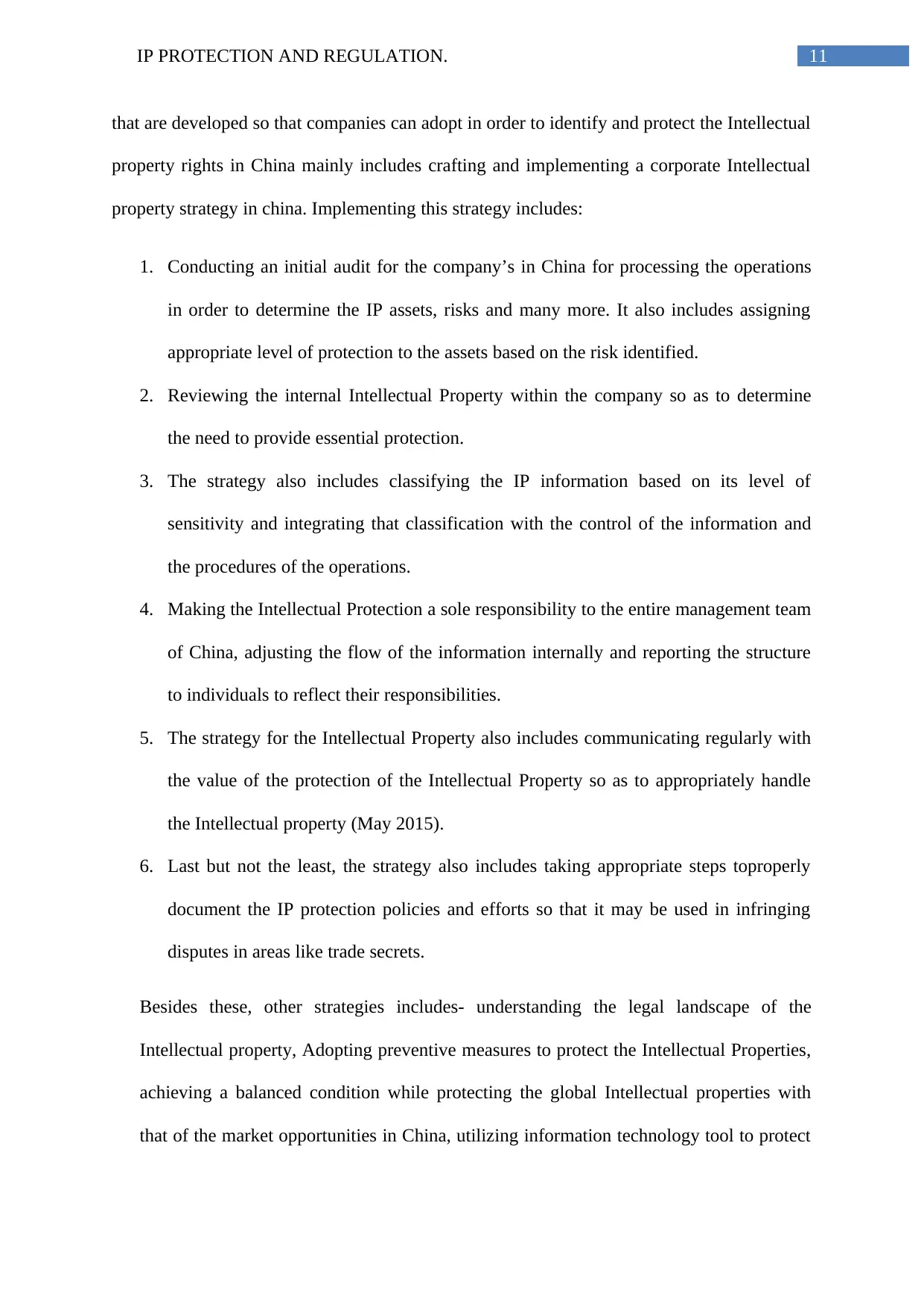
11IP PROTECTION AND REGULATION.
that are developed so that companies can adopt in order to identify and protect the Intellectual
property rights in China mainly includes crafting and implementing a corporate Intellectual
property strategy in china. Implementing this strategy includes:
1. Conducting an initial audit for the company’s in China for processing the operations
in order to determine the IP assets, risks and many more. It also includes assigning
appropriate level of protection to the assets based on the risk identified.
2. Reviewing the internal Intellectual Property within the company so as to determine
the need to provide essential protection.
3. The strategy also includes classifying the IP information based on its level of
sensitivity and integrating that classification with the control of the information and
the procedures of the operations.
4. Making the Intellectual Protection a sole responsibility to the entire management team
of China, adjusting the flow of the information internally and reporting the structure
to individuals to reflect their responsibilities.
5. The strategy for the Intellectual Property also includes communicating regularly with
the value of the protection of the Intellectual Property so as to appropriately handle
the Intellectual property (May 2015).
6. Last but not the least, the strategy also includes taking appropriate steps toproperly
document the IP protection policies and efforts so that it may be used in infringing
disputes in areas like trade secrets.
Besides these, other strategies includes- understanding the legal landscape of the
Intellectual property, Adopting preventive measures to protect the Intellectual Properties,
achieving a balanced condition while protecting the global Intellectual properties with
that of the market opportunities in China, utilizing information technology tool to protect
that are developed so that companies can adopt in order to identify and protect the Intellectual
property rights in China mainly includes crafting and implementing a corporate Intellectual
property strategy in china. Implementing this strategy includes:
1. Conducting an initial audit for the company’s in China for processing the operations
in order to determine the IP assets, risks and many more. It also includes assigning
appropriate level of protection to the assets based on the risk identified.
2. Reviewing the internal Intellectual Property within the company so as to determine
the need to provide essential protection.
3. The strategy also includes classifying the IP information based on its level of
sensitivity and integrating that classification with the control of the information and
the procedures of the operations.
4. Making the Intellectual Protection a sole responsibility to the entire management team
of China, adjusting the flow of the information internally and reporting the structure
to individuals to reflect their responsibilities.
5. The strategy for the Intellectual Property also includes communicating regularly with
the value of the protection of the Intellectual Property so as to appropriately handle
the Intellectual property (May 2015).
6. Last but not the least, the strategy also includes taking appropriate steps toproperly
document the IP protection policies and efforts so that it may be used in infringing
disputes in areas like trade secrets.
Besides these, other strategies includes- understanding the legal landscape of the
Intellectual property, Adopting preventive measures to protect the Intellectual Properties,
achieving a balanced condition while protecting the global Intellectual properties with
that of the market opportunities in China, utilizing information technology tool to protect
⊘ This is a preview!⊘
Do you want full access?
Subscribe today to unlock all pages.

Trusted by 1+ million students worldwide
1 out of 19
Related Documents
Your All-in-One AI-Powered Toolkit for Academic Success.
+13062052269
info@desklib.com
Available 24*7 on WhatsApp / Email
![[object Object]](/_next/static/media/star-bottom.7253800d.svg)
Unlock your academic potential
Copyright © 2020–2025 A2Z Services. All Rights Reserved. Developed and managed by ZUCOL.




